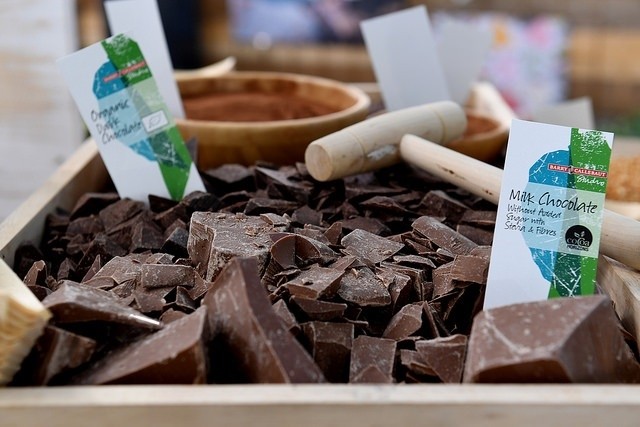Barry Callebaut sweetens appeal of healthier chocolate with low-sugar range

The products are a move by the Belgium-based firm to hone in on the lifestyle choices millennial and health-conscious adults are making to limit sugar intake whilst practising “healthy indulgence”.
“Nowadays, consumers want to enjoy food without feeling guilty,” said Bas Smit, global and EMEA marketing director at Barry Callebaut. “This trend is spreading through Europe and the world.”
Latest figures suggest the message to reduce dietary sugar is having the desired effect. 49% of global consumers try to limit their sugar intake, while 23% try to eat a moderate amount of sugar and 14% avoid it entirely.
Barry Callebaut’s range presented at the recent FiE event in Frankfurt includes dark or milk chocolate that uses a dietary fibre blend to replace part of the ingredient’s sugar content.
The firm also offer dark, milk and white chocolate with maltitol as a sugar replacer or as a combination with a fibre blend and stevia, where the final recipe contains only 20% of polyols.
A total sugar-free option is also available with the sweeteners maltitol and stevia used along with milk proteins to replace the lactose-containing milk powder.
Reformulation chocolate challenges
“The pressure to reduce the sugar intake is increasing tremendously but poses major challenges at the technological level when applied to chocolate,” said Leen Allegaert, global R&D program manager at Barry Callebaut.
“Since 2007, we have been working on chocolate reformulation developing sugar substituting technologies that is ready for customer-specific developments as well as chocolate and filling recipes that are either reduced in sugar or free of added sugar,” she added.
Like most suppliers of chocolate and cocoa products, Barry Callebaut has come under pressure to reformulate a high-sugar and fat product that fits into today’s health conscious consumer.
However, the indulgent nature of chocolate and confectionery means consumers absolutely demand no compromises on taste and texture in their enjoyment of the product.
As Barry Callebaut have demonstrated, sugar replacers such as stevia and fibre are able substitutes although a recent review stated that the effect of these approaches on the bioactive effects of chocolate is largely unknown.
Speaking to ConfectioneryNews last month, Charlotte Green from Divine Chocolate, believed consumers were acting on the link between higher cocoa content and lower sugar content, boosting overall sales in dark chocolate.
However, Dr Duane Mellor, co-author of the review and senior lecturer in human nutrition at Coventry University, added that chocolate products making cocoa flavanol health claims today were quite niche as companies were struggling to overcome the bitter taste.
"For chocolate in particular the problem is that because these compounds of interest are quite bitter you rarely get a commercial product that has a significant amount of flavonoids.”
Allegaert responded stating that “Cocoa flavanols are naturally present in the cocoa bean and are components with proven health effects when consumed."
“The 2013 health claim was the first in the cocoa and chocolate industry. Barry Callebaut was able to provide evidence that the daily intake of 200 milligrams (mg) of cocoa flavanols supports a normal blood circulation by helping to maintain the elasticity of the blood vessels.
“This claim can be used for cocoa beverages (with cocoa powder) or for dark chocolate providing at least a daily intake of 200 mg of cocoa flavanols. Cocoa beverages can be formulated to an indulgent product, while the high flavanol dark chocolate is powerful in taste and provides the daily dosage in a serving of only 10 grams (g).”
Barry Callebaut has licensed its health claim to only a few chocolate brands, such as Vandenbulcke's ChoVita and the Good Chocolate Company's brand Lavlé.
Other brands such as Mars, who have invested heavily in cocoa flavanol research, have taken a different route choosing to focus on its use in supplements.
The Mars-backed FLAVIOLA project previously stated chocolate is too calorific to be a delivery vehicle for cocoa flavanols.
Novel ingredients for health & flavour
Boosting cocoa flavanol content is one way to boost the food’s health profile.
Companies such as Chocumin and Georgia Nut have been innovating with turmeric as an alternative approach as are UK firm The Raw Chocolate Company and Redd Superfood, who both use goji berries to increase antioxidant content.
Allegaert agreed that focusing on the goodness of the ingredients represented another way of making healthier products.
“Adding superfoods, like superfruits, ancient grains or nuts, matches very well in taste with chocolate,” she said.
“It is possible to make the overall product better in nutritional profile and will surely bring the sensorial experience to the next level by the combination of textures.”
The sensorial experience also extends to a notable rise in exotic flavours such as chilli, fennel, basil and cardamom, as well as an Eastern influence seen with matcha green tea, miso, wasabi and soy sauce.
Notable chocolatiers include luxury British chocolate brand Montezuma, whose bars of dark chocolate with chilli, ginger and Lime are now available in the UK in Sainsbury’s supermarkets.
Belgian company Cosijns Chocolatier make available its Chocolats au matcha, white chocolate squares with matcha powder packaged in a 100g tube.
Consumers around the globe love discovering (and often rediscovering) new flavours,” said Allegaert.
“At Barry Callebaut we closely observe these trends and with our global network of chefs we experiment to see what chocolate experiences of tomorrow could be like in confectionery, pastry, biscuits or ice cream.
“Next to that we are also continuously exploring sensory aspects of cocoa and chocolate and make sure we have chocolates that best pair with new exciting flavours.”
























